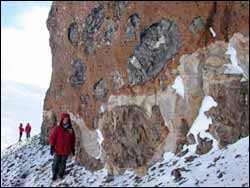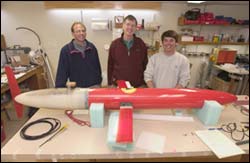
High in the mountains of Antarctica, Ohio State University geologists unearthed the fossil remains of a 180-million-year-old clam-like creature that was preserved in a very unusual way: by the ancient bacteria that devoured it.
And only yards away, they found the first fossil evidence of a completely different kind of bacteria that scientists were unsure even existed as fossils that long ago.
The first find answers one of the most fundamental questions in paleontology —
Global research highlighting the most important areas for albatross migration and breeding may yet help save these magical birds from extinction.
Satellite tracking data for 16 species of albatross and three petrel species, all of them threatened by commercial and pirate longline fishing, have been collated by BirdLife International, an alliance of conservation groups. Its report, Tracking Ocean Wanderers, highlights areas where longline fleets are putting seabirds at most risk. T
A Johns Hopkins University graduate student may have solved a problem that has been baffling marine biologists and paleontologists for years: Why do coral reefs disappear from the fossil record during the beginning of the Cretaceous period — 120 million years ago — only to reappear after its end 35 million years ago?
The possible answer: Ancient seawater’s low magnesium-to-calcium ratio during this interval made it difficult for the marine animals — which build their sk
NASA scientists recently found the El Nino Southern Oscillation (ENSO) is the main driver of the change in rain patterns all around the world.
The NASA and Japan Aerospace Exploration Agency (JAXA) Tropical Rainfall Measuring Mission (TRMM) satellite has enabled scientists to look around the globe and determine where the year-to-year changes in rainfall are greatest. The TRMM is a joint mission between NASA and JAXA designed to monitor and study tropical rainfall.
Resear
Rice U. geologists probe impact of rising seas along US Gulf Coast
New research presented at this week’s annual meeting of the Geological Society of America shows that rising sea levels of as little as a half-meter per century have been sufficient to dramatically change the shoreline of the U.S. Gulf Coast within the past 10,000 years. The findings are significant because half-meter increases are within the moderate range of predictions for the Gulf Coast during this century.

Like the sailing vessel used by Captain Joshua Slocum to sail solo around the world 100 years ago, another ocean-going vehicle is making history. A small ocean glider named Spray is the first autonomous underwater vehicle, or AUV, to cross the Gulf Stream underwater, proving the viability of self-propelled gliders for long-distance scientific missions and opening new possibilities for studies of the oceans.
Launched September 11, 2004, about 100 miles south of Nantucket Island,